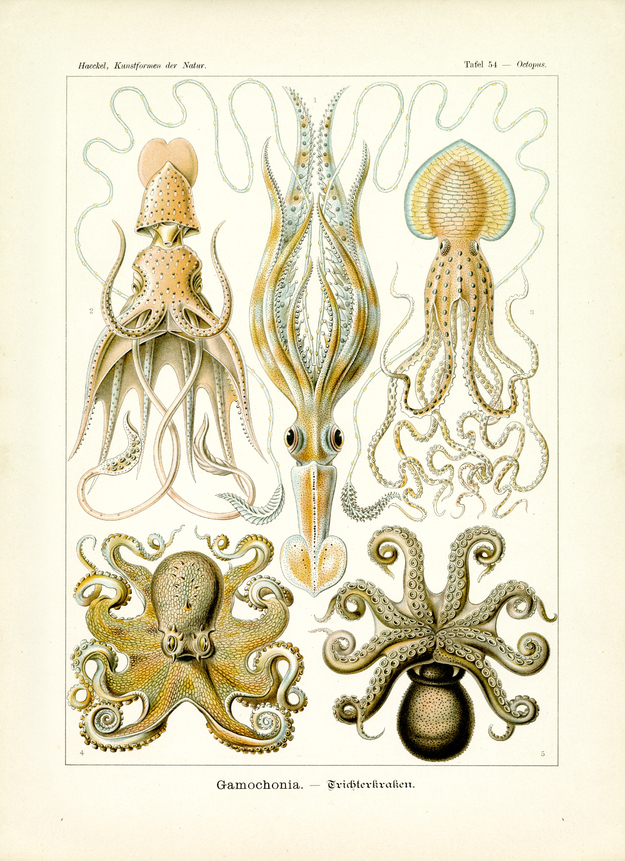Translation of the original German introduction by Ernst Haeckel:
Octopus or “ink fish”, illustrated on this plate, belong to the younger legion of Gamochonia or “Cephalopoda with ‘tube-funnel’”. In these highly organized mollusk, “funnel” means the posterior part of the foot (Podium), i.e. the central sole or foot plate that earlier Mollusca as well as snails of today use for crawling locomotion. In the older legion of Tomochonia or “Cephalopoda with ‘cleft-funnel’”, of which only one single kind is living today, “Nautilus” (‘pearl boat’), the lateral lopes of the posterior foot, ‘Epipodial-lopes’, are curved against each other with the rims folded one on top of the other so that they present a cone-shaped leaf rolled like a paper-bag. In the younger Gamochonia both rims of this leaf are completely grown together so that the bag becomes a cone-shaped funnel, open at the top and at the base; in the centre of figure 2 this funnel is visible as a triangular organ in between head (below) and body (above). Water is taken into the ‘cover-cavity’ through the upper (bigger) opening of the funnel, it is ejected through the lower (smaller) opening when contracting the funnel; with the help of strong repulsion when ejecting water the body swims with the tailfin on top of the back (in fig. 1 down, in fig. 2 and 3 on top) moving in front.
In all Cephalopoda the anterior part of the foot is split into lopes, many of which have developed into strong arms. Since these arms surround the big head (with a pair of huge eyes) in the form of a corona octopus are usually called “head-pedes”. In all living octopuses (except Nautilus) the very flexible and muscular arms are beaded with powerful suckers that usually appear in two rows. The family of Octolenae (fig. 4 and 5) possesses eight such tentacles. In the family of Decolentae (fig. 1-3) two special, extremely elongated tentacles are added. They carry suckers only at the thickened end and can be retracted into special tentacle pouches. All living octopuses are Dibranchia (‘two-gilled’); the only exception is the old Nautilus, equipped with ‘cleft funnel’ and doubled respiratory organs; it therefore represents the special group of Tetrabranchia (‘four-gilled’). The impressive lime shell, filled with air chambers - a characteristic Nautilus shares with Ammonitae, illustrated on plate 44 - is regressed in most living Gamochonia or has completely disappeared. The bright shimmering skin of living octopuses usually shows a most beautiful play of colours.
Translation by VR Translators Bangalore
We've scanned the original lithography at 1200dpi on the Epson A3 scanner of A3 scanner huren. You can download a 400dpi JPEG here.
